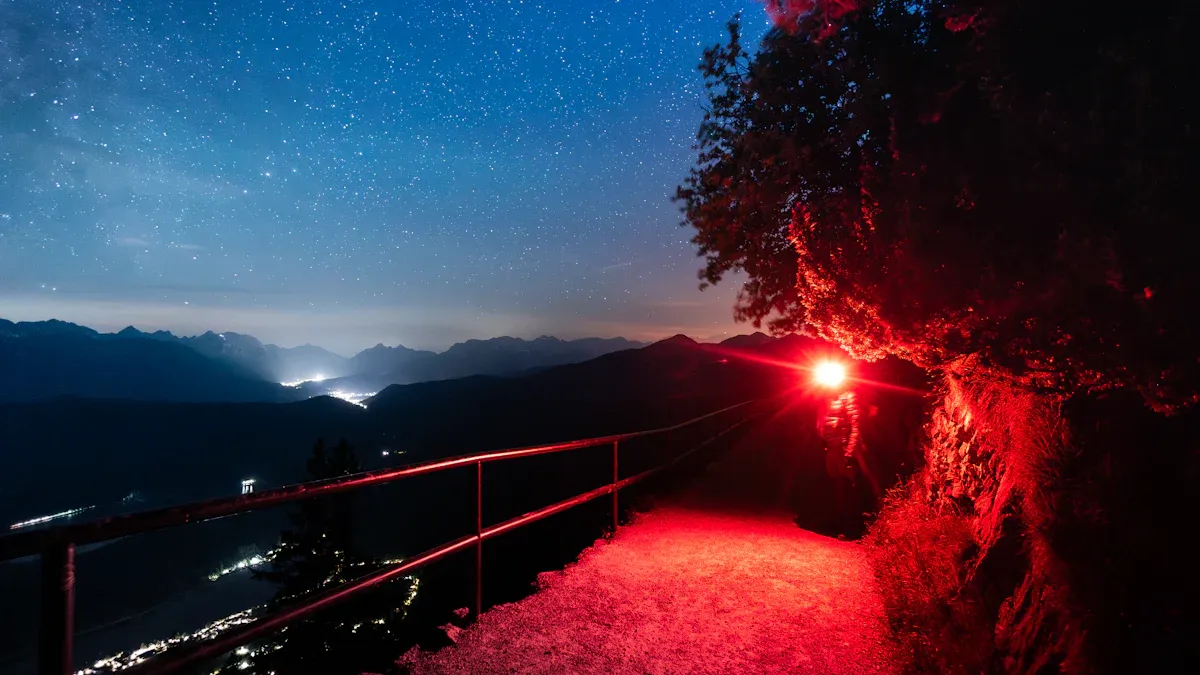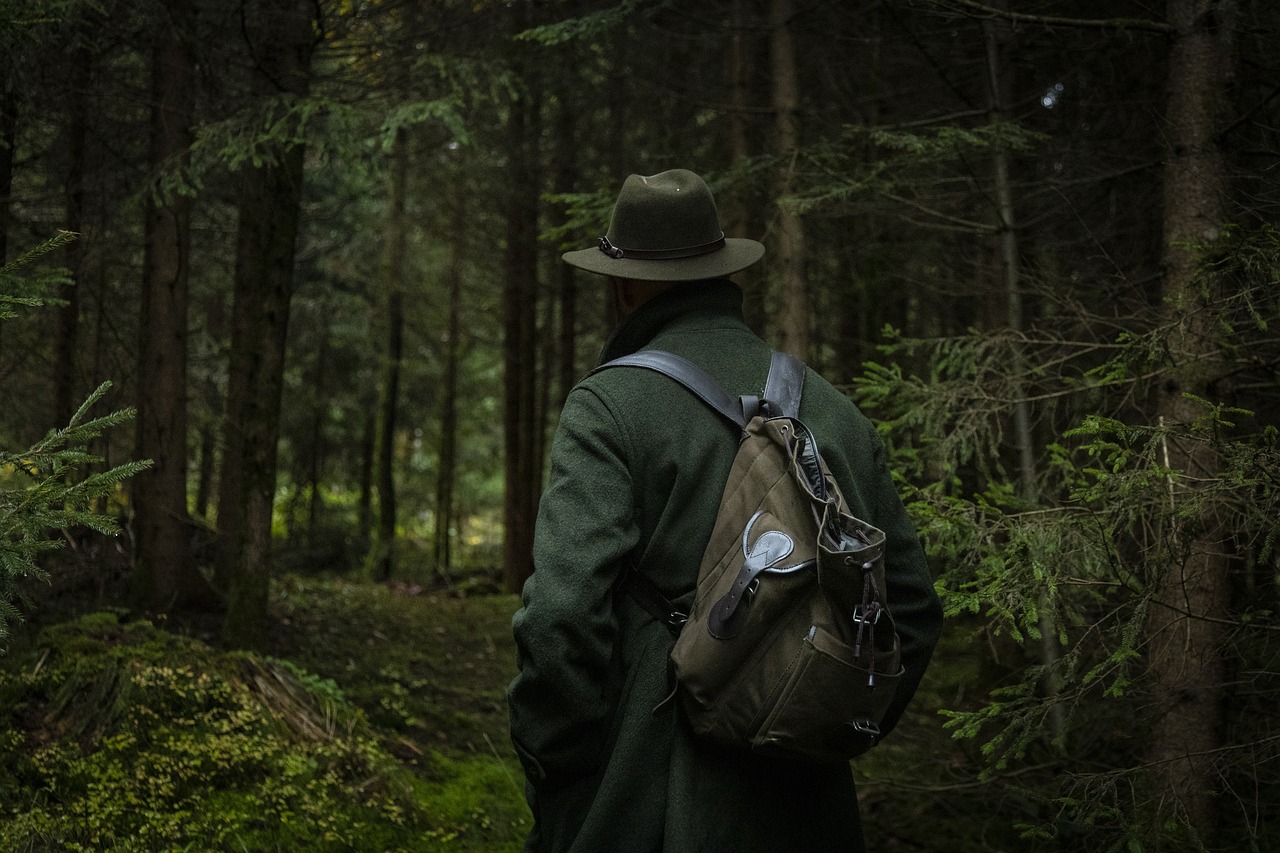Mastering Night Hiking: Flashlight Tips for Beginners

Hiking at night is exciting but requires proper tools and planning. A good hiking flashlight is very important. It helps you see the trail and stay safe. Being ready keeps you protected and makes the hike fun. Are you excited to explore the wonders of night hiking?
Key Takeaways
A good flashlight is essential for night hiking. Choose one with 200-400 lumens for most trails, or up to 1000 lumens for camping.
Always carry a backup light source and extra batteries. This ensures you stay prepared if your main light fails.
Hiking with friends enhances safety and enjoyment. They can help in emergencies and keep you motivated during the hike.
Benefits of Night Hiking
Seeing nature in a new way
Hiking at night feels magical and different. Trails you know well seem new under your flashlight's glow. The dark lets you see animals like owls or deer that hide during the day. Have you ever listened to nighttime sounds? Rustling leaves and animal calls make it peaceful and exciting.
Night hiking also lets you enjoy amazing views, like sunsets or sunrises from quiet spots. These moments feel special because they’re rare. It’s like nature’s gift for trying something new.
Cooler weather and quiet trails
Hiking in the hot sun can be tiring. At night, cooler air keeps you comfy and less sweaty. You can enjoy the hike without worrying about water as much.
Trails are calmer at night with fewer people around. You can enjoy the quiet and look at the stars. Maybe you’ll even see a shooting star. These calm moments make night hiking unforgettable.
Facing night hiking challenges
Night hiking is more than beauty—it’s an adventure. Walking in the dark tests your focus and skills. A good flashlight is very important. Some hikers have trouble because they didn’t prepare.
Don’t let that scare you. With planning, challenges become fun. Beating them feels great and makes the hike even better.
Essential Gear for Night Hiking

Choosing the best hiking flashlight
A good hiking flashlight is your best friend on night trails. It helps you see clearly and avoid obstacles. When picking one, think about your needs. Are you going for a short hike or a long adventure? For most hikes, a flashlight with 200-400 lumens works well. If you’re camping, you might need 500-1000 lumens.
Here’s a quick guide to help you choose:
Feature | Details |
|---|---|
Brightness | 500 lumens |
Beam Distance | 200 meters |
Battery Type | 3 AA batteries |
Waterproof Rating | IPX4 |
Price Range | $15 - $25 |
Many hikers love flashlights with BatteryGuard technology. It prevents battery drain and keeps your light ready when you need it. Lightweight and durable flashlights are also great for hiking.
Advantages of using headlamps
Headlamps are a game-changer for night hiking. They free up your hands, making it easier to navigate or carry hiking gear. Most headlamps offer adjustable brightness (80-150 lumens), so you can adapt to different conditions. Rechargeable headlamps last longer and are eco-friendly.
Another perk? Headlamps provide both spot and flood beams. This versatility is perfect for tasks like cooking or reading maps.
Importance of backup lighting and extra batteries
Always carry a backup light source. A small flashlight or extra headlamp can save the day if your main light fails. Pack extra batteries too. Aim to have enough power for twice the planned duration of your hike.
Other essential gear for night hiking
Besides a strong and reliable light source, pack essentials like a map, compass, and first aid kit. Many hikers recommend models like the Black Diamond Spot for their reliability. Don’t forget warm clothing and snacks to keep your energy up.
Flashlight Tips for Beginners
Picking the right brightness
Choosing the right flashlight brightness is very important. If it’s too dim, you won’t see well. If it’s too bright, it can hurt your eyes or bother others. Many flashlights let you adjust brightness for different needs. For most trails, 200-400 lumens work fine. For rough paths or camping, you might need up to 1000 lumens.
Flashlights are tested to make sure they work well. Tests like luminous intensity checks and certifications like ANSI/NEMA FL1 help ensure quality. These tests show if a flashlight is good for night hiking.
Test Name | What It Does |
|---|---|
Luminous Intensity Test | Measures how bright the light is in one direction. |
Certification Check (e.g., ANSI/NEMA FL1) | Confirms flashlight quality, like brightness, runtime, and beam distance. |
Saving battery power
Battery life is very important for night hiking. To avoid running out, pick the right battery type. Alkaline batteries are cheap but don’t last long. Lithium-ion batteries are lightweight and great for bright settings. NiMH batteries are rechargeable and eco-friendly but lose power over time.
Battery Type | Features |
|---|---|
Alkaline Batteries | Cheap but don’t last long. |
Lithium-Ion Batteries | Lightweight and last longer. |
NiMH Batteries | Rechargeable but lose power slowly. |
Use lower brightness to save battery power. Turn off your flashlight during breaks. Always carry extra batteries to stay prepared.
Using a flashlight the right way
Using a flashlight isn’t just about turning it on. Hold it near your waist to see better and avoid glare. If you use a headlamp, tilt it to light the path without hurting your neck. Look around often to spot animals or obstacles.
Don’t shine your flashlight at others. It can distract them or hurt their eyes. Practice these tips to hike safely and enjoy the night.
Why red-light settings are helpful
Red-light settings are great for night hiking. Red light doesn’t hurt your night vision as much as white light. It helps your eyes adjust to the dark better.
Red light keeps your night vision strong when switching between light and dark.
It’s great for reading maps or walking without bothering others.
Animals are less scared by red light, making it easier to watch them.
People like astronomers and sailors use red light to see in the dark without losing visibility. If your flashlight has this feature, try it on your next hike!
Night Hiking Safety Tips
Learn about the trail
Before you go, learn about the trail first. Knowing the path helps you prepare and avoid problems. Studies show 41% of lost hikers leave the trail because they didn’t know it (National Geographic).
Here’s how to stay safe:
Look at maps and guides to know the route.
Tell someone your hiking plan before you leave.
Notice landmarks or signs to stay on the right path.
This planning helps you enjoy your hike and not get lost.
Hike with friends or a group
Hiking with others is fun and safer too. Friends can help in tough spots or emergencies. If someone gets hurt, like twisting an ankle, the group can help them.
Why group hiking is great:
Everyone helps watch for dangers.
Quick help if there’s an accident.
Encouragement to keep going when it’s hard.
So, bring a friend or join a group for your night hike.
Watch for animals and your surroundings
Animals are more active at night. They often avoid people, so they’re harder to see. Stay alert by listening and using your flashlight to look around.
Tip: Don’t make loud noises or sudden moves. This keeps you safe and doesn’t scare animals.
Be ready for weather changes
Weather can change fast at night. A weather tool like a Kestrel Meter can help you track changes. Always pack extra clothes to stay warm and dry.
Check the weather before you go, but be ready for surprises. Being prepared keeps you safe and comfortable.
Packing Essentials for Night Hiking
Dressing for changing weather
Weather at night can be unpredictable. Wear layers to stay comfy. Start with a base layer that keeps sweat off your skin. Don’t wear cotton—it holds moisture and makes you cold. Pick fabrics like merino wool or synthetic ones instead.
If it’s cold, add a mid-layer like fleece or a thermal shirt. This helps trap heat and keeps you warm. Always pack a waterproof jacket to block wind or rain. Bring extra clothes in case the weather changes quickly.
Tip: Wash your base layers often to keep them fresh and working well.
Bringing food and water for energy
You need energy and water for night hiking. Pack snacks like trail mix, energy bars, or dried fruit. These are easy to eat and give quick energy.
Drink enough water—about 0.5 to 1 liter per hour. For long hikes, bring electrolyte tablets to stay balanced and avoid dehydration. Always carry extra water for emergencies.
Note: Dehydration can happen fast. Sip water often to stay safe.
Packing a first aid kit and emergency items
Accidents can happen anytime. Always carry a small first aid kit. Include bandages, antiseptic wipes, and pain medicine. Pack an emergency blanket to stay warm if you’re stuck outside longer than planned.
Other helpful items are a loud whistle to call for help and a Personal Locator Beacon (PLB) for remote areas. These tools can save lives in emergencies.
Making a packing checklist
A checklist helps you remember everything important. Sort your gear into groups like clothes, food, and safety tools. Use small bags to keep things neat and easy to find.
Packing Tips | Description |
|---|---|
Organize gear | |
Pack heavy items | Place heavy things near your back for better balance. |
Keep essentials handy | Put snacks and maps in pockets you can reach easily. |
Test your gear | Check all your equipment before hiking to make sure it works. |
Pack your bag a few days early. This gives you time to check everything and avoid rushing.
Pro Tip: Always bring a map and compass, even if you know the trail well.
Getting ready makes night hiking fun and safe. A good flashlight or headlamp helps you see clearly. Bring extra batteries and wear strong shoes for unexpected events. GPS tools help you stay on the right path easily. With proper gear and a positive attitude, enjoy the excitement of hiking at night.
FAQ
What’s the best way to test my flashlight before a night hike?
Turn it on and check all brightness settings. Test the battery life by leaving it on for a while.
Tip: Always carry spare batteries or a backup flashlight!
How do I avoid disturbing wildlife during a night hike?
Use a red-light setting on your flashlight. Walk quietly and avoid sudden movements. Stay on the trail to minimize your impact.
Can I use my phone’s flashlight instead of a hiking flashlight?
Your phone’s flashlight isn’t reliable for long hikes. It drains your battery quickly and doesn’t provide enough brightness for rugged trails.
Note: A dedicated hiking flashlight is a must for safety.
See Also
Essential Tips for Selecting the Best Flashlight for Hiking
A Beginner's Guide to Selecting the Ideal Hunting Flashlight
Key Considerations for Picking the Perfect Camping Flashlight
